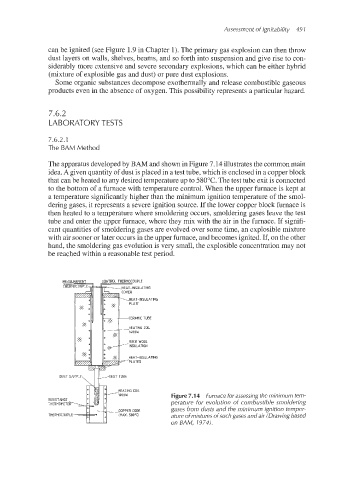Page 524 - Dust Explosions in the Process Industries
P. 524
Assessment of lgnitability 49 I
can be ignited (see Figure 1.9 in Chapter 1). The primary gas explosion can then throw
dust layers on walls, shelves, beams, and so forth into suspension and give rise to con-
siderably more extensive and severe secondary explosions, which can be either hybrid
(mixture of explosible gas and dust) or pure dust explosions.
Some organic substances decompose exothermally and release combustible gaseous
products even in the absence of oxygen. This possibility represents a particular hazard.
7.6.2
LABORATORYTESTS
7.6.2.1
The BAM Method
The apparatus developed by BAM and shown in Figure 7.14 illustrates the common main
idea. A given quantity of dust is placed in a test tube, which is enclosed in a copper block
that can be heated to any desired temperature up to 580°C. The test tube exit is connected
to the bottom of a furnace with temperature control. When the upper furnace is kept at
a temperature significantly higher than the minimum ignition temperature of the smol-
dering gases, it represents a severe ignition source. If the lower copper block furnace is
then heated to a temperature where smoldering occurs, smoldering gases leave the test
tube and enter the upper furnace, where they mix with the air in the furnace. If signifi-
cant quantities of smoldering gases are evolved over some time, an explosible mixture
with air sooner or later occurs in the upper furnace, and becomes ignited. If, on the other
hand, the smoldering gas evolution is very small, the explosible concentration may not
be reached within a reasonable test period.
Figure 7.1 4 Furnace for assessing the minimum tem-
perature for evolution of combustible smoldering
gases from dusts and the minimum ignition temper-
THERMOCOUPLE ature of mixtures of such gases and air (Drawingbased
on BAM, 1974).

